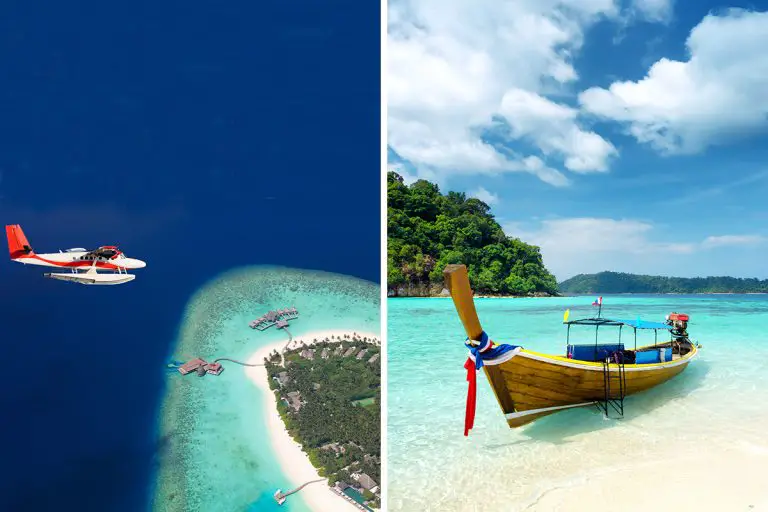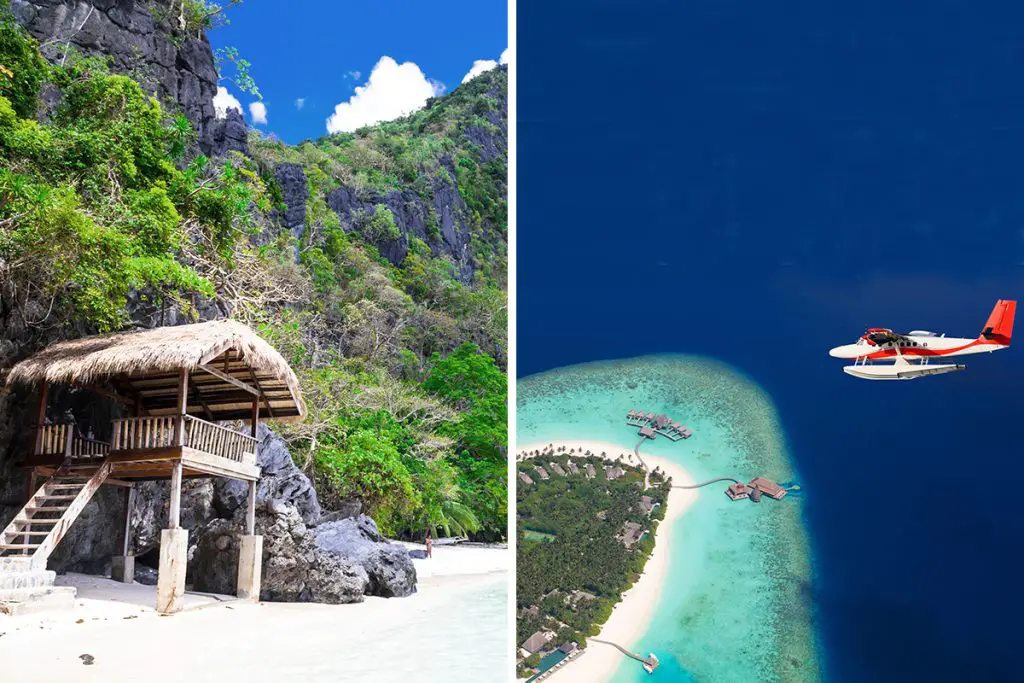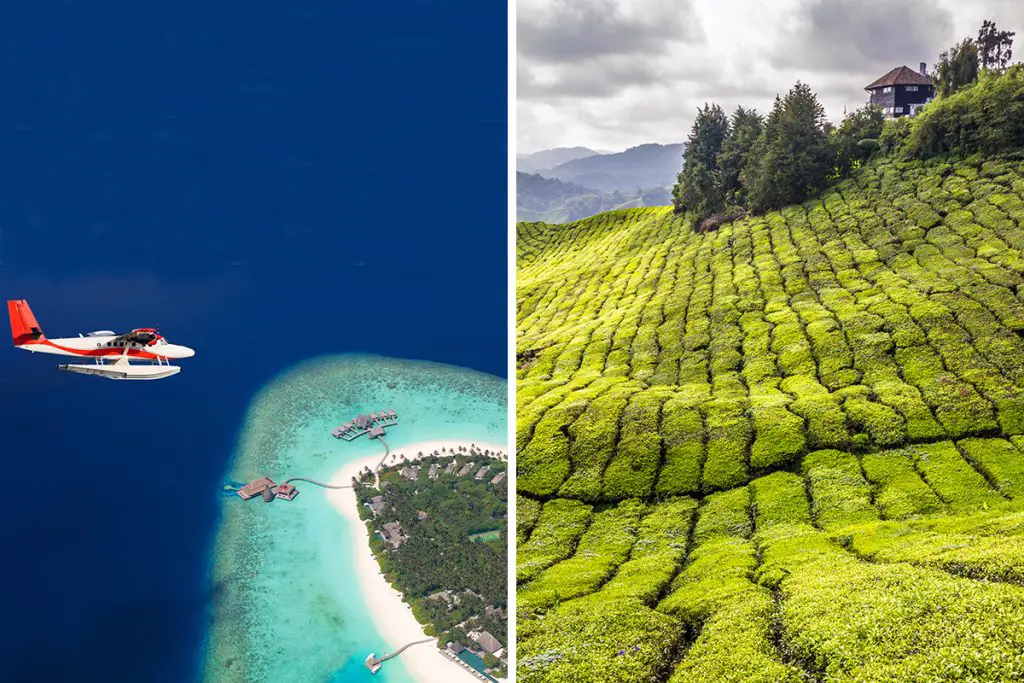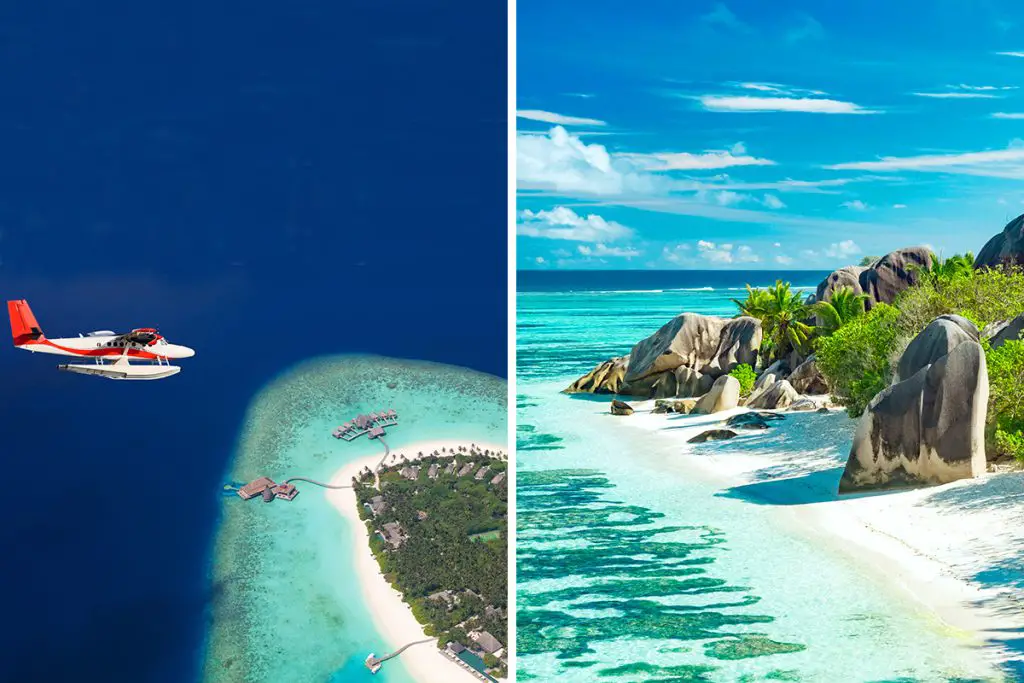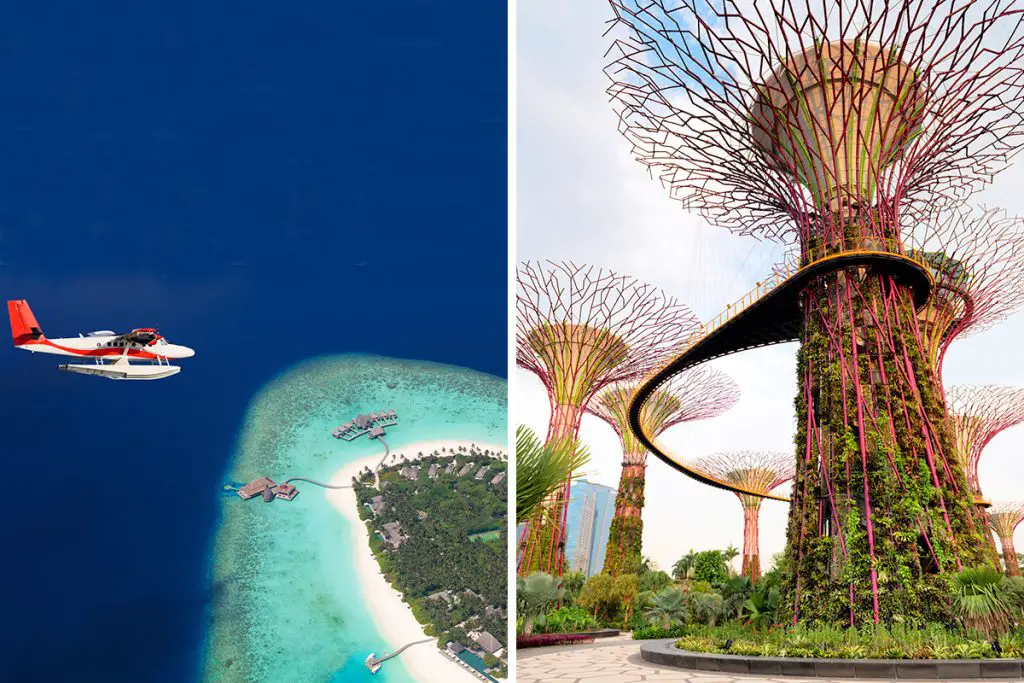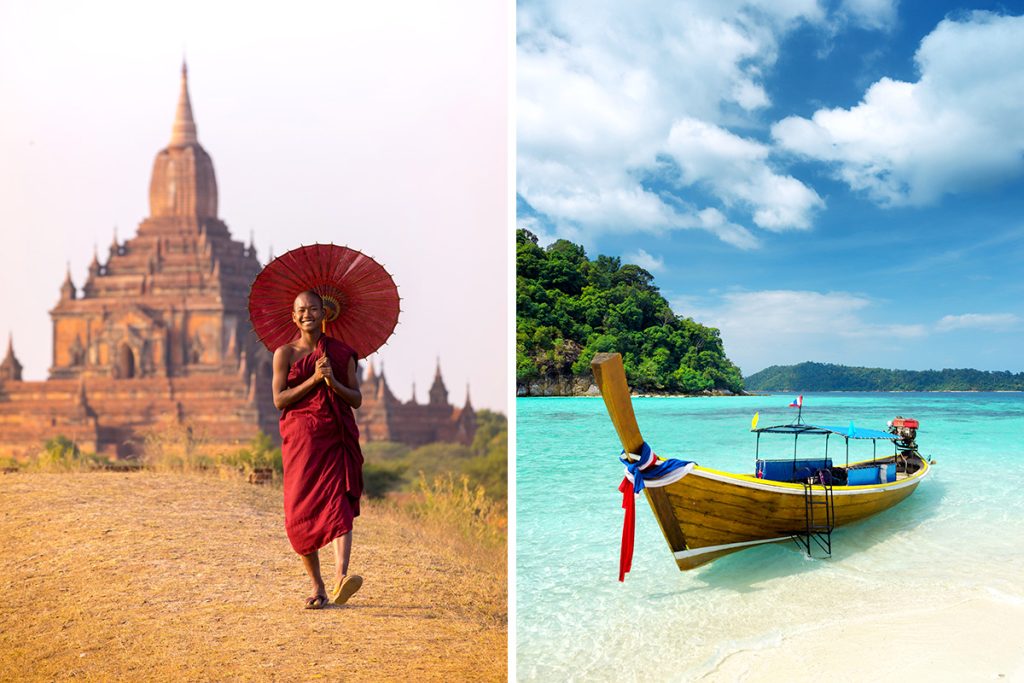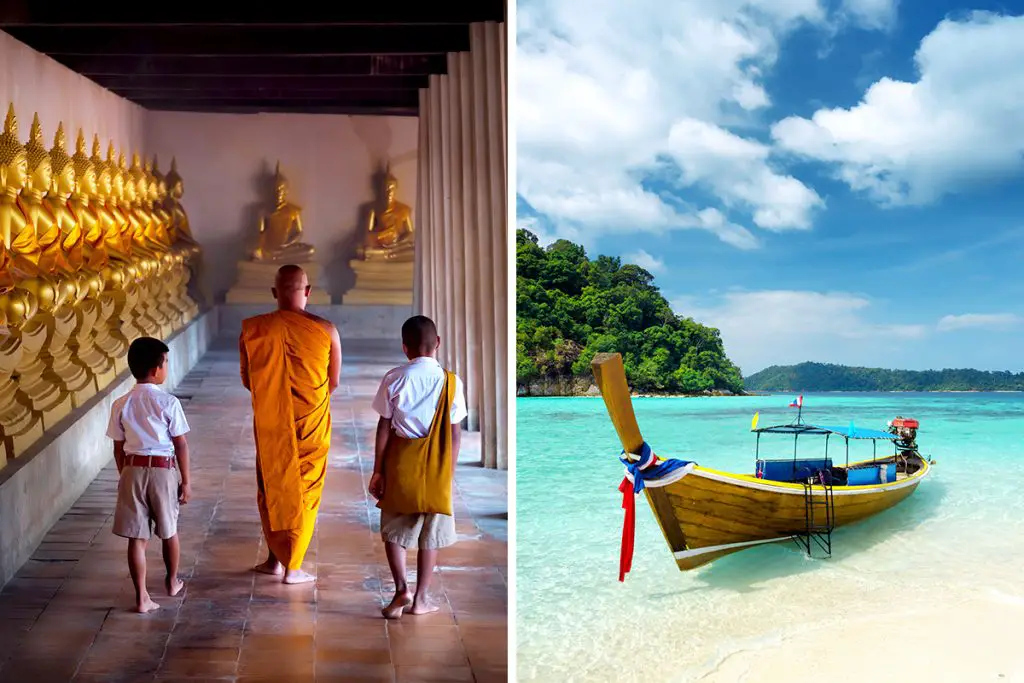Both destinations have their unique allure. The Maldives is your go-to for an idyllic escape, where the ocean’s hues seem almost unreal. Thailand, however, offers a kaleidoscope of experiences, from ancient temples to modern skyscrapers. Intrigued? Keep reading to find out which destination aligns best with what you’re looking for.
History & Culture
First off, let’s dive into the rich history and culture of these two fascinating destinations. While they both offer stunning natural beauty, the Maldives and Thailand differ significantly in their historical backgrounds and cultural landscapes.
The Maldives is a tropical paradise in the Indian Ocean, but its history is less explored than its beaches. The country has a mix of influences from Africa, Asia, and the Middle East. Islam is the dominant religion, and you’ll find that the culture is deeply rooted in Islamic traditions.
The Maldives has its own language, Dhivehi, and a unique script. While the culture is less diverse than Thailand’s, it offers a serene and focused experience that revolves around island life.
Thailand, in contrast, has a rich and complex history that dates back thousands of years. The country was never colonized, which allowed its culture to evolve without significant foreign influence. Buddhism is the main religion, and it shapes much of the country’s traditions and daily life.
Thailand is known for its festivals, like Songkran and Loy Krathong, which are celebrated with enthusiasm across the country. The Thai language and its script are also unique but have influences from Sanskrit and Pali, ancient languages from India.
In the Maldives, the culture is more homogenous, centered around island communities and the sea. Traditional music and dance, like Bodu Beru, are popular, but the cultural scene is not as varied as in Thailand.
Thailand offers a more diverse cultural experience. You’ll find a range of artistic expressions, from traditional Thai dance to modern cinema. The country is also known for its martial art, Muay Thai, and its traditional form of healing, Thai massage.
In summary, if you’re looking for a tranquil, less diverse cultural experience, the Maldives is your destination. But if you’re intrigued by a rich, multifaceted culture with deep historical roots, Thailand will be more up your alley. Both offer unique experiences that can enrich your understanding of the world, so your choice ultimately depends on what you’re looking to get out of your trip.
Attractions & Activities
When it comes to attractions and activities, both the Maldives and Thailand offer a plethora of options that can make any vacation unforgettable. However, the types of attractions and activities you’ll find in each destination are as different as night and day. Let’s delve into what each has to offer.
In the Maldives, one of the most popular activities is scuba diving. The underwater world here is teeming with vibrant coral reefs and a variety of marine life. The Banana Reef and Manta Point are must-visit diving spots.
If you’re into water sports, you can also try your hand at windsurfing or paddleboarding. For a unique experience, you might want to visit the Maldives’ underwater restaurant, Ithaa, where you can dine with a 180-degree view of the ocean around you.
Thailand, on the other hand, offers a different set of attractions. The ancient city of Ayutthaya and the historic ruins at Sukhothai give you a glimpse into Thailand’s rich history.
For nature enthusiasts, trekking in Chiang Mai or exploring the caves in Mae Hong Son offers an adventurous escape. If you’re into wildlife, the Elephant Nature Park provides an ethical way to get up close with these majestic creatures.
While the Maldives focuses more on water-based activities and luxurious experiences, Thailand offers a broader range of attractions, from historical sites to natural wonders. In Thailand, you can also take part in cooking classes to learn how to make traditional Thai dishes, or visit a floating market for a unique shopping experience.
In summary, the Maldives is the place to be if you’re looking for water-based activities and a luxurious, laid-back vacation. Thailand, however, offers a more diverse range of activities, from exploring ancient ruins to trekking through lush landscapes. Your choice will depend on what kind of experiences you’re eager to have.
Beaches
Now, let’s talk about the beaches, which are often the highlight of any tropical vacation. Both the Maldives and Thailand boast some of the world’s most beautiful coastlines, but they offer different experiences. Let’s compare.
The Maldives is famous for its private island resorts, where each resort occupies its own island. The beaches here are pristine, with powdery white sand and crystal-clear waters. The average temperature of the water is around 82°F (28°C), making it perfect for swimming. The distance between islands can vary, but they’re generally about 1 to 2 miles (1.6 to 3.2 km) apart.
Thailand’s beaches are more diverse and often more crowded. Places like Phuket and Krabi offer a variety of beach experiences, from secluded spots to areas bustling with activity. The water temperature is similar to the Maldives, averaging around 82°F (28°C). However, the beaches are part of larger landmasses, so they can stretch for several miles (kilometers).
In the Maldives, the focus is on privacy and luxury. Many resorts offer private beach areas where you can relax without being disturbed. In Thailand, the beaches are more social, with opportunities for various water sports and activities.
If you’re looking for long stretches of uninterrupted sand, Thailand might be more your speed. But if you’re after a more private, exclusive beach experience, the Maldives is hard to beat.
In summary, both destinations offer stunning beaches but in different flavors. The Maldives provides a more secluded, private experience, while Thailand offers a social, diverse beach environment. Your choice will depend on what kind of beach experience you’re looking for.
Eating, Drinking & Nightlife
When it comes to eating, drinking, and nightlife, the Maldives and Thailand offer distinct experiences that cater to different tastes. Whether you’re a foodie, a partygoer, or someone who enjoys a quiet drink, you’ll find something to love in both destinations. Let’s break it down.
In the Maldives, dining is often an intimate, luxurious affair. Many resorts offer private dining experiences, where you can enjoy a meal on a secluded part of the beach or even underwater, as in the case of the Ithaa Undersea Restaurant. The cuisine is heavily influenced by the sea, so expect a lot of seafood dishes, often prepared with coconut and spices.
Thailand’s culinary scene is a feast for the senses. Street food is a big deal here, and you can find everything from Pad Thai to mango sticky rice at roadside stalls. Cities like Bangkok and Chiang Mai are food havens, offering a wide range of options from traditional Thai dishes to international cuisine.
When it comes to drinking, the Maldives is a bit more restricted due to its Islamic culture. Alcohol is generally only available within the resorts. However, many resorts offer a wide range of international wines and cocktails, often enjoyed at sunset overlooking the ocean.
In Thailand, the drinking culture is more open and social. You’ll find a variety of bars, from rooftop lounges in Bangkok to beach bars in Phuket. Local beers like Singha and Chang are popular, as are cocktails made with Thailand’s famous spirit, Mekhong.
Nightlife in the Maldives is generally low-key, focused on romantic dinners and stargazing. Thailand, however, has a vibrant nightlife with nightclubs, live music, and full-moon parties, particularly in places like Bangkok and Pattaya. In summary, the Maldives offers a more secluded, romantic experience when it comes to eating, drinking, and nightlife. Thailand, on the other hand, provides a lively, social atmosphere with a wide range of options to suit all tastes.
Shopping
Shopping in the Maldives and Thailand offers two very different experiences, each with its own unique charm. Whether you’re looking for luxury items or local crafts, both destinations have something special to offer.
In the Maldives, shopping is generally confined to the resorts or the capital city of Malé. You’ll find boutique stores offering luxury items like designer clothing and jewelry. Local markets in Malé also offer Maldivian crafts, such as lacquerware and woven mats.
Thailand is a shopper’s paradise, especially in cities like Bangkok. The Chatuchak Weekend Market, one of the largest in the world, offers everything from antiques to fashion. For luxury shopping, malls like Siam Paragon and CentralWorld offer a range of high-end brands. In places like Chiang Mai, you can find local crafts like silk, ceramics, and wood carvings.
While the Maldives focuses on luxury and local crafts, Thailand offers a broader range of shopping experiences. You can haggle in the bustling markets or browse through high-end malls.
In summary, if you’re looking for exclusive, luxury shopping, the Maldives is your go-to destination. But if you’re after variety and the thrill of finding unique items, Thailand is hard to beat. Both offer unique shopping experiences that can add an extra layer of enjoyment to your trip.
Accommodation
When it comes to laying your head down after a day of adventure, both the Maldives and Thailand offer a range of accommodation options that cater to different tastes and preferences. Let’s explore what each destination has in store for you.
In the Maldives, the focus is on luxury and privacy. Many resorts occupy their own private islands, offering overwater bungalows that give you direct access to the ocean. These bungalows often come with glass floors, allowing you to observe marine life without even leaving your room. Amenities like private pools, personal butlers, and spa services are common.
Thailand, on the other hand, offers a wider variety of accommodation options. In bustling cities like Bangkok, you’ll find everything from boutique hotels to hostels. In more rural areas like Chiang Mai, guesthouses and eco-lodges are popular. For a unique experience, you can even stay in a traditional Thai teak house.
While the Maldives leans towards secluded luxury, Thailand offers diversity. Whether you’re looking for a high-rise hotel with a city view or a cozy guesthouse in a small village, Thailand has it all.
In summary, the Maldives specializes in luxurious, private accommodations that bring you close to the sea. Thailand offers a broader range of options, from urban hotels to rural guesthouses, catering to various travel styles.
Family-Friendliness & Children’s Activities
When traveling with family, especially with children, the activities and amenities available can make or break your vacation. Both the Maldives and Thailand offer family-friendly options, but in different ways.
In the Maldives, many resorts offer kids’ clubs that feature a variety of activities like treasure hunts, cooking classes, and snorkeling lessons. Some resorts even have dedicated children’s pools and play areas.
Thailand is a playground for kids and adults alike. From elephant sanctuaries where you can feed and bathe these gentle giants, to cultural activities like traditional Thai dance classes, the options are endless. Theme parks like Siam Park City in Bangkok offer a day of fun rides and water activities.
While the Maldives provides a more controlled, resort-based experience for families, Thailand offers a wide array of activities that can be educational as well as fun.
In summary, the Maldives offers a luxurious, contained environment that’s great for families looking for a laid-back vacation. Thailand, however, provides a more dynamic range of activities that can be both fun and educational for children.
Getting There & Getting Around
Getting to and navigating through your chosen destination are crucial parts of any trip. Both the Maldives and Thailand have their own sets of advantages and challenges when it comes to transportation.
To get to the Maldives, you’ll most likely fly into Malé International Airport. From there, you’ll take a seaplane or a speedboat to your resort, which could be anywhere from 20 to 90 miles (32 to 145 km) away. Seaplanes are a quicker but more expensive option, while speedboats offer a more leisurely pace.
In Thailand, major international airports like Suvarnabhumi in Bangkok and Phuket International Airport serve as key entry points. Once you land, you have a variety of options like taxis, buses, and even tuk-tuks to get you to your accommodation.
For getting around in the Maldives, your options are somewhat limited to boats and domestic flights between islands. In Thailand, the transportation network is more extensive. You can take domestic flights, buses, or trains to travel between cities. Within cities, public transport like the BTS Skytrain in Bangkok makes getting around easy and efficient.
In summary, the Maldives offers fewer but more specialized options for getting there and getting around, often involving boats or seaplanes. Thailand has a more extensive and varied transportation network, making it easier to explore different parts of the country.
Weather
Weather can be a deciding factor when choosing between the Maldives and Thailand for your vacation. Both destinations offer tropical climates, but there are some key differences to consider. Let’s dive into the specifics.
The Maldives enjoys a hot, tropical climate year-round. The dry season runs from November to April, with temperatures averaging around 81-86°F (27-30°C). The wet season, from May to October, sees more rainfall but still offers warm temperatures in the same range.
Thailand also has a tropical climate but with more variation. The cool season from November to February sees temperatures ranging from 64-89°F (18-32°C). The hot season from March to May can get quite warm, with temperatures soaring up to 95°F (35°C). The rainy season from June to October is humid but still warm, with temperatures ranging from 75-89°F (24-32°C).
In the Maldives, you’ll find more consistent weather, making it easier to plan your trip. In Thailand, the weather can vary significantly depending on the region and time of year.
In summary, the Maldives offers a more consistent tropical climate, ideal for beach activities and water sports. Thailand provides a wider range of weather experiences, which might suit travelers looking for variety.
Safety
Safety is a top concern for any traveler, and both the Maldives and Thailand have their own safety profiles. Let’s delve into what you can expect in each destination.
The Maldives is generally considered a safe destination for tourists. The resorts are well-secured, and crime rates are relatively low. However, it’s essential to respect local customs and laws, especially since the Maldives is an Islamic country.
Thailand is also considered safe for tourists, but it’s a much larger country with more urban areas, so it’s advisable to stay alert in crowded places. Scams targeting tourists can occur, so it’s good to be cautious.
In terms of unique non-crime topics, the Maldives is at risk for rising sea levels due to climate change, which is an ongoing concern. Thailand faces challenges related to air quality, especially in cities like Bangkok.
In summary, both destinations are generally safe for tourists but come with their own sets of considerations. The Maldives offers a more controlled environment, while Thailand requires a bit more vigilance due to its size and diversity.
Cost
When planning a trip, the cost is often a significant factor to consider. Both the Maldives and Thailand offer different experiences at different price points. Let’s compare.
In the Maldives, dining is usually tied to the resort where you’re staying. A meal can cost around 300 Maldivian Rufiyaa (about 20 US dollars ). Transportation is often by seaplane or speedboat, which can be pricey but is usually included in your resort package.
Thailand offers a wider range of options. Street food can cost as little as 30 Thai Baht (around 1 US dollar ), while a meal at a mid-range restaurant might set you back 400 Thai Baht (about 6 US dollars ). For getting around, local buses and trains are quite affordable, often costing less than 50 Thai Baht (around 1.5 US dollars ).
For the battle of the average nightly rates for mid-range accommodations, it is $750 vs. $110—Maldives and Thailand, respectively. Try to wrap your head around that!
In summary, the Maldives is a more expensive destination, hands down, focusing on luxury and exclusivity. Thailand offers a broader range of options that can accommodate various budgets, from backpackers to luxury seekers.
Which Is Better – Maldives or Thailand?
Choosing between the Maldives and Thailand for your next vacation is no small feat. Both destinations offer unique experiences that can make your trip unforgettable. Let’s summarize what we’ve learned to help you make an informed decision.
In terms of history and culture, the Maldives offers a more homogenous experience rooted in Islamic traditions and island life. Thailand, however, boasts a rich, multifaceted culture influenced by Buddhism and a history that spans thousands of years. If a diverse cultural experience is what you’re after, Thailand is the better choice.
When it comes to attractions and activities, the Maldives specializes in water-based adventures and luxurious experiences. Thailand offers a broader range of activities, from historical sites to natural wonders. If you’re looking for variety, Thailand has the edge.
For beaches, the Maldives provides a more secluded, private experience, while Thailand offers a social, diverse beach environment.
Eating, drinking, and nightlife in the Maldives are generally more luxurious and intimate, with a focus on resort-based experiences. Thailand offers a bustling culinary scene, a more open drinking culture, and vibrant nightlife. If socializing and trying a variety of foods and drinks are high on your list, Thailand is the place to be.
Shopping in the Maldives is more about luxury and exclusivity, often within the confines of your resort or in the capital city of Malé. Thailand is a shopper’s paradise, offering everything from bustling markets to high-end malls. For shopaholics, Thailand is the clear winner.
Accommodation in the Maldives leans towards secluded luxury, often in the form of private island resorts. Thailand offers a wider range of options, from boutique hotels in cities to guesthouses in rural areas. If you’re looking for diversity in your lodging options, Thailand takes the cake.
Family-friendliness and children’s activities in the Maldives are often tied to the resort, offering a controlled environment. Thailand offers a broader range of activities that can be both fun and educational for kids.
For transportation, the Maldives is more specialized, often involving seaplanes or speedboats, while Thailand offers a more extensive network of buses, trains, and domestic flights. Weather-wise, the Maldives offers more consistency, while Thailand offers more variety.
Safety and cost considerations also vary, with the Maldives being more expensive and controlled, and Thailand offering more budget-friendly options and requiring a bit more vigilance.
In conclusion, if you’re looking for a luxurious, intimate, and controlled environment, the Maldives is your go-to destination. If you prefer a trip filled with diverse experiences, cultural richness, and a variety of options in food, lodging, and activities, Thailand is the better choice for you.

